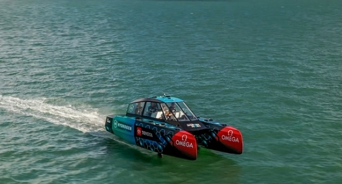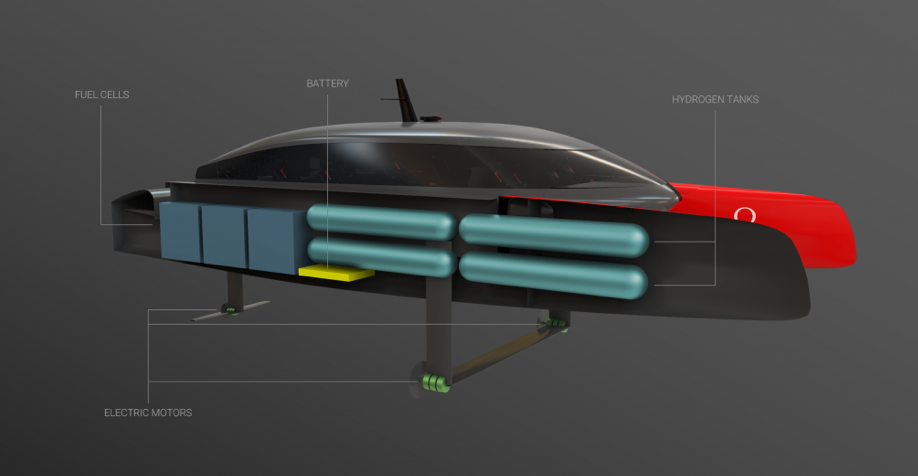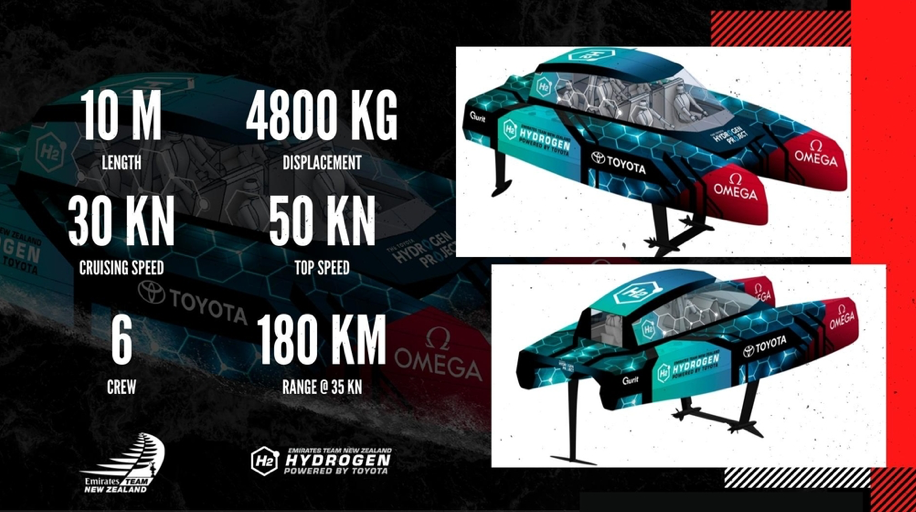Hydrogen-Powered Foiling Chase Boat Takes Flight
Less than a year after announcing plans to build a hydrogen-powered foiling chase boat, the Emirates Team New Zealand prototype boat underwent a successful water test in Auckland, New Zealand.
The catamaran Chase Zero is being built as a chase boat for the 37th America’s Cup taking place in Barcelona. As the defending America’s Cup champion, the Emirates Team New Zealand team sets the protocols for the 2024 race and made the zero carbon emissions a priority.
Each team competing will be required to build a minimum of two hydrogen fuel cell chase boats to be used in the 20-plus events leading up to the America’s Cup.
Ambitious Project

Since announcing the project in June, the ETNZ Hydrogen project has moved quickly from a concept to a reality. The chase boat was built at the team’s base in Auckland Viaduct Harbour and is part of an effort to drive clean technologies in the marine industry.
Consultants said it would take longer than a year to build the 33-foot boat, which can carry a crew of six people with a range of up to 100 miles.
“We were basically told something as audacious as Chase Zero would take 3.5 to 4 years, but this has effectively taken us just over 9 months.” said project Manager Geoff Senior. “I think there's almost no other boats like this around. The next boats like this are still a long way away, so I think once it's in the water and running, we will realize just how important it is on the world stage.”
Splashed in the Water

Chase Zero went into the water for the first time on April 6 in Waitemata Harbor and is undergoing a “highly measured and stringent commissioning process,” Senior said. The commissioning process is expected to take several weeks.
Senior said every element of the hydrogen-powered boat was tested independently before bringing it up to foiling flight mode. The height is controlled by an autopilot.
The test was a major step forward with construction starting on the prototype boat in August.
“This really is a considerable step forward in clean renewable energy in the marine industry,” said Kevin Shoebridge, Emirates Team New Zealand’s chief operating officer. “Looking at Chase Zero foiling along today, it looks like a futuristic power boat, but then you actually need to remind yourself that there are zero carbon emissions. It is basically water vapor coming out of the exhaust which is amazing when considering the positive environmental impact that can be made by reducing emissions from regular boat engines.”
How it Works

Chase Zero is powered by two 80kW Toyota hydrogen fuel cells that provide most of the energy needed to power the boat. Green hydrogen is stored in gas form at 350bar. Tanks are made from a plastic liner wrapped in carbon fiber for the required strength. Each tank holds 17.6 lbs. (8kg), giving the boat a total capacity of 70.55 lbs. (32kg). The hydrogen gas is passed through a catalyst that strips the electrons away from the H2 molecules.
These electrons are used to power the boat and then return to the positively charged H+ ions which are combined with oxygen from the air, leaving nothing but H2O to exit the exhaust of the fuel cell. This electricity is then either stored in the battery or fed directly into the electric motors that provide the propulsion to the boat.
“The fuel cells provide the majority of the energy, however the battery acts as a filter for the faster changes in power demand,” said Michael Rasmussen, an electrical engineer on the boat. “The response time of the fuel cell is much slower than available from the battery, so during fast changes in demand the battery supplies the difference as a compromise in performance was not an option.”
Rasmussen said the battery is used to achieve higher speeds. The boat can cruise at approximately 35 mph with the 160kW generated from the fuel cells. To achieve the higher-end speeds towards 57 mph, the batteries can produce 420kW for shorter periods.
“The fuel cell will then recharge the batteries once there is excess power available again,” Rasmussen said.
Chase Zero by the Numbers

The prototype chase boat is nearly 33 feet (10 meters) and weighs approximately 11,464 pounds (5,200 kg). Designers estimate the cruising speed will be 34-40 mph (30-35 knots) with a top speed of around 57 mph (50 knots).
The boat is built to carry six crew members with a range of between 93-112 miles (150-180 km). The range is within the typical chase boat working cycle. Powering the boat is a pair of 220kw motors with four hydrogen tanks and two batteries supplying the power.
What’s Next?

The Chase Zero team will continue testing the prototype boat over the coming weeks. Engineers expect the boat to be ready when the sailing competitions start later this year.
“This project is all about proving how we can influence the global marine industry by producing a prototype hydrogen powered foiling catamaran,” Shoebridge said, “and today has been a huge progression towards that. We have no doubt there will be a lot of entities and organizations that will be watching and thinking how the technology can be adapted to their specific use case or ideas.”